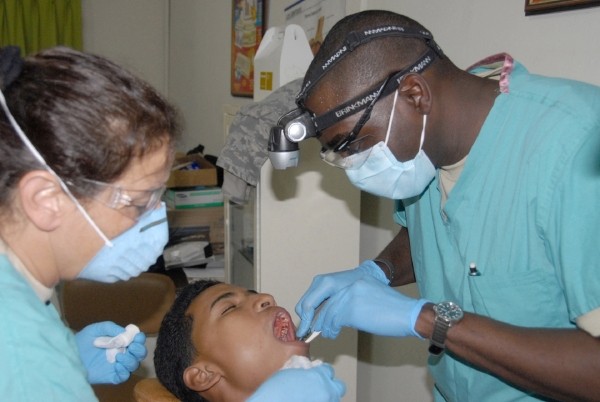
Did you know that 30- 40 million Americans avoid visits to the dentist due to fears?
This represents between 9% and 15% of the population—potentially 9 to 15% of your own patient base.
We know that many people are not getting to their dentist for a number of reasons, but a survey from British Dental Health found that as many as 36% of the non-visiting population are not going due to fears that they have.
To be clear, there is a big difference between the anxiety brought on by having fears and the all-consuming panic that can be induced when someone has a dental phobia.
Patients who suffer from anxiety can usually still find a way to make themselves go through with a dental appointment, although they may have put it off for a long time. They often suffer from exaggerated fears about their appointment and might spend a sleepless night beforehand worrying about it.
A phobia is a much more serious psychological condition that leaves the patient with a very intense sense of dread. As Colgate puts it:
“A phobia is an intense, unreasonable fear. People can fear a specific activity, object or situation. People with dental phobia often put off routine care for years or even decades. To avoid it, they’ll put up with gum infections (periodontal disease), pain, or even broken and unsightly teeth.
Dental phobia, like other mental disorders, can be treated. Without treatment, dental phobia is likely to get worse over time. That’s partly because emotional stress can make dental visits more uncomfortable than they need to be.”
Patients with odontophobia may not have visited a dentist in years. They’re more likely to suffer from acute health problems because of this.
Those who have anxiety rather than a phobia are more easily reassured, although there are things you can do to make both groups more comfortable.
Let’s look at a few fears that dental patients typically have and how to help them overcome them.
Dental patients can come with a number of fears, but you can help ease them. Click To TweetFor many patients, a large amount of anxiety can stem from a fear of the unknown. Perhaps they haven’t been a regular at the dentist and they’re nervous about the unfamiliar environment and new faces. Sometimes they’re even worried about the dentist or dental team themselves.
Other potentially unknown quantities might include the actual procedure they’re going to have, what to expect once they’re in the dental chair and what to expect following the procedure. Whether or not they’re going to face a large bill can also bring significant anxiety.
We all want to emphasize empathetic patient care and the development of good relationships, right? It’s better for the patient and better for your business. To this end, there are a number of things you can do to help ease anxiety about “the unknown.”
Here are some ideas:

How comfortable are you with someone else in the driver’s seat? For many people, this is a significant cause of anxiety. For dental patients, all sorts of fears may be running through their minds.
They have to remain still in a dental chair while trusting someone else to poke around in their mouth, perhaps doing a procedure that involves some discomfort. What happens if they need to swallow, feel pain, or just have a need to get up and move? That sense of lacking control can really hit some people hard, especially when they may have had an unpleasant experience in the past.
The “fight or flight” response in our brains can be a powerful urge, so it’s important that you and your team realize that loss of control can be a real issue.
The patient doesn’t need to feel that they lack control. In fact, you can establish a way to help them feel that they are maintaining control the whole time. For example, you could establish a clear signal that they can use to indicate “stop” at any time during the procedure. This might simply involve them raising their hand. Let them know that if they do this at any stage, you will immediately stop and give them a breather.
You only have to look at statistics put out by the CDC to realize that many Americans haven’t been to their dentist in a very long time. Of course, for those who haven’t been a regular in their dentist’s office, they are more likely to be suffering from the ill effects of oral diseases.
For many, this is a source of severe embarrassment. The following point from Colgate highlights the perspective of someone with a dental phobia, but this kind of anxiety may equally be felt by someone who hasn’t been to the dentist because they couldn’t afford it:
“People with dental phobia have a higher risk of gum disease and early tooth loss. Avoiding the dentist may have emotional costs as well. Discolored or damaged teeth can make people self-conscious and insecure. They may smile less or keep their mouths partly closed when they speak. Some people can become so embarrassed about how their teeth look that their personal and professional lives begin to suffer. There is often a serious loss of self-esteem.”
This person is worried about how you and your team will react. Will they feel humiliated when they come into the dental office?
In these situations, it’s important to stress professionalism, empathy, and a genuine desire to see the patient reach a position of good health. Ease their fears by explaining that you see a range of dental conditions every day as part of your job.
Empathize and let the patient know that you completely understand if they have been unable to get their condition treated before—you see this kind of thing every day and it is your mission to help them feel better.
Make sure that professionalism is stressed with your team, too. A patient should never overhear team members gossiping about another patient, for example. This would only serve to escalate their own feelings of embarrassment.
How many of us were raised with horror stories of past dental care or perhaps experienced some horrors ourselves? These tales of pain and discomfort have often become part of urban legend, adding to the anxiety of patients.
Some will come in with fears that are genuinely based on past experiences, while others may have had fear passed on from others. For some, they may be worried that their mouth will be stuffed full of equipment, triggering their sensitive gag reflex. Others might worry about discomfort because they don’t feel able to breathe properly through their nose.
While there might have been some genuine horrors of dentistry in the distant past, we all know that procedures have come a long way in terms of technology and methods applied to make them more comfortable.
You can help the anxious patient by explaining to them exactly how the procedure will work, along with giving them a way to maintain control, such as in our previous section. An extraction sounds ominous if the patient is unaware that they won’t feel it at all.
For mouth breathers, solutions such as nasal strips or nitrous oxide to help them relax and breathe better may help.
Those with a sensitive gag reflex may benefit from being offered a panoramic x-ray or just the opportunity at any time to take a break.
There are a number of factors about the environment of the dental office that can be triggers for anxiety. You’ve got loud noises, the squeal of the drill, the dental chair, sharp, scary-looking dental implements, funny smells, and tight spaces.
Any of these things can trigger phobias and/or anxiety. Sometimes this will also be related to a fear of the unknown or unfamiliar.
First of all, every dental practice should work to create a calming environment that helps to relax patients. Some examples of this include playing light, ambient music, offering scented pillows or heat packs, and even paraffin hand spas.
Anxious patients might be comforted by noise-cancelling headphones or solutions as simple as not reclining the dental chair the whole way.
It’s natural to worry about sharp things being near your mouth, so a suggestion for patients who are particularly worried could be to let them hold some of the tools and become familiar with them.
Besides that, try to maintain a pleasant smell (some offices use diffusers for this) and take a cue from the patient if they need space. Let them know they can ask for a break.
Top patient care is something that you can really make your dental practice known for, and this includes supporting anxious patients or those who may have genuine phobias.
Making a conscious effort to be adaptable and accommodating is an overall message to take away. Anxiety or fear comes in all shapes and sizes and sometimes it’s the small details that really count to help make someone feel more comfortable.